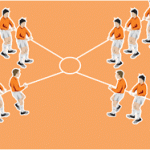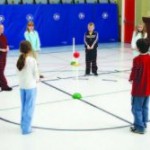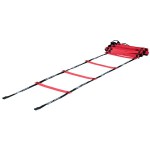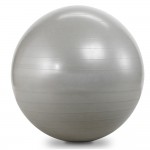3. Knee Tag: Everybody It
Setup and Equipment:
- Boundary line markers
- Yarn balls for a variation of the game
- One of the out of bounds line is the fence, then set up other boundary lines using boundary markers or ropes.
Guidelines:
- Students line up behind their cones to start.
- This is an “Everybody It” Game:
- The object of this game is to tag other players on the knee.
- Students use a two-fingered (peace tag) on the knee.
- If you get tagged on the knee, you immediately go down to one knee and extend a hand. You may continue playing the game after a classmate gives you a “five” with their hand.
- You are immune from getting tagged whenever you are standing still with your hands covering your knees.
- The 3 second rule applies for immunity, so you can’t do it for very long.
- You may not move or run with hands on your knees.
- This is continuous game.
Speed Up Variation: To add some excitement near the end of the activity. Stop the game and tell everyone that there is one rule change, for the next minute you cannot cover your knees so there are no bases and the other tag rules remain.
Variation: Choose the Taggers: This time hand out yarn ball taggers to 4 people and they are the only taggers. In this game, if a yarn ball tags you anywhere on your body, go to one knee and one of your friends will give you a high five to free you.
- THE MOST FUN WINS!




